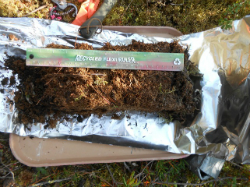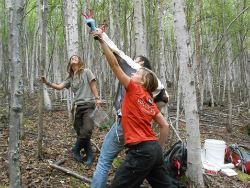SERDP (Strategic Environmental Research and Development Program)
In Alaskan boreal forest, fire is a common disturbance that can alter forest successional trajectories, plant-soil-microbial feedbacks, and permafrost stability. Fires are becoming larger, more frequent, and more severe in the boreal region. Forecasts of future climate suggest that this trend will continue and could alter forest composition. Black spruce (Picea mariana) is the most common tree species in Interior Alaska and is typically associated with slow decomposition rates, a thick organic layer, and a shallow active layer depth. Following severe fires that burn deeply into the organic layer, spruce forest can give way to deciduous stands, which typically cycle nutrients more quickly, have a shallow organic layer, and may reduce insulation of permafrost.
We are studying the mechanistic linkages among vegetation type, the soil organic layer, and permafrost ground stability. This project is a collaborative effort between empirical researchers and modelers, aimed at assessing these relationships and predicting the response of permafrost ground and fire disturbance regimes to projected changes in climate. Our empirical research is based largely near Murphy Dome, near Fairbanks, Alaska. Here we have adjacent black spruce and Alaska paper birch (Betula neoalaskana) plots where we are quantifying carbon and nitrogen pools and fluxes.
We are also studying the impacts of tree leaf litter on moss survival to assess controls on organic layer re-accumulation following fire. Additionally, we are quantifying the effects of forest management on forest carbon losses and permafrost stability and have sampled sites spanning from Fairbanks to Fort Greely.
Concurrently, we are working to couple two computer models so that we can predict how fire regime and tree seedling establishment influence ecosystem structure and function as climate in the region continues to change.
 |
 |
Organic layer collected in a black spruce stand (by April Melvin) |
Sampling fresh foliage in a paper birch stand near Murphy Dome (by April Melvin) |
back to research













